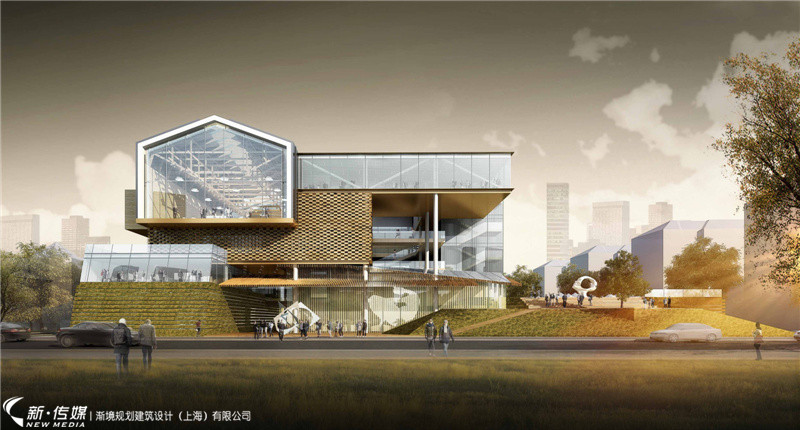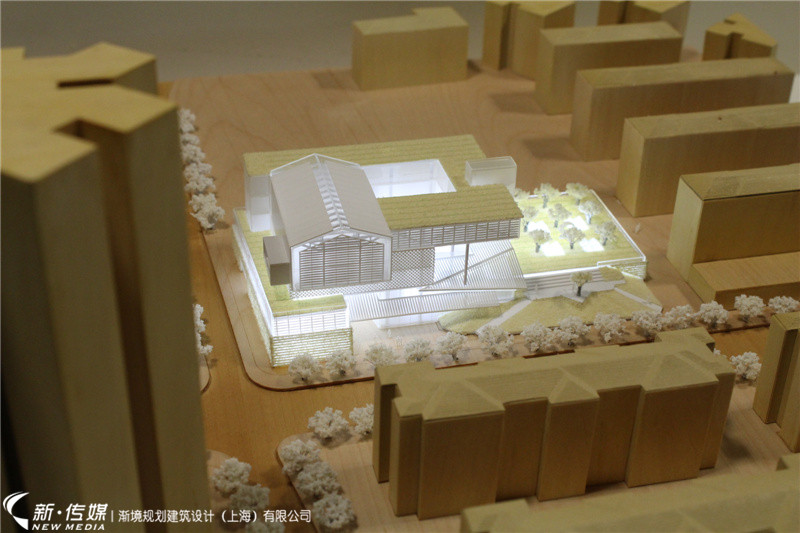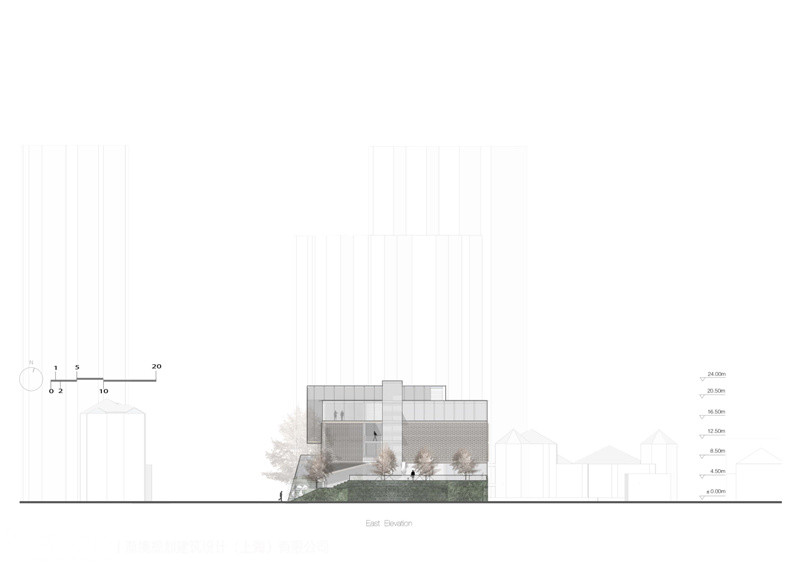康健街道社区综合楼Kangjian community center 2015-11-24 稿源:abbs建筑论坛
项目名称:康健街道社区综合楼
项目地址:上海市徐汇区
项目业主:上海市徐汇区人民政府康健新村街道办事处
项目设计:S³-lab 渐境规划建筑设计(上海)有限公司
项目主设计师:董明
参与人员:韩再宇,孙琦,王嫣,Pierre(法国建筑师),Lidia(俄罗斯建筑师)
设计时间:2015年5月
项目面积:占地面积:3960㎡
建筑面积:12000㎡
项目介绍:
项目现状:
本项目位于上海市徐汇区西南部,浦北路与百花街交口的东北角地块。占地面积4,080平方米。项目所在的康健社区是一个80年代中后期开始建设、以居民住宅区为主的社区。经过多年的开发、完善,社区环境清雅宜居,生活环境温馨和谐。是一个成功的新型社区案例。
•Project background:
The Project is located at the south-west part of Xuhui, Shanghai, the northeast intersection of Pubei Road and Baihua Street. With the plot size of 4080m2, the project is in the Kangjian Neighborhood which was constructed during 80s. With a majority of residential program, Kangjian Neighborhood is now an extraordinary example of a desirable living community
•项目优劣势:
Background Analysis:
优势:
A.项目处于别墅区、多层住宅区和高层住宅区的结合部位;北临学校,西接社区商业中心。人口组成丰富,商业与人文气息兼得。是一个建设社区中心的理想所在。
B.浦北路道路尺度适宜,绿化良好,恬静祥和。
C.项目东西两边的建筑高度适宜。北侧紧邻学校操场,远处为别墅用地,此方向上具备良好的视野。
Advantage:
A.The project is located in the intersection zone of several residential buildings. Adjacent to school at the north side and commercial center at the west side, the site has already built up a desirable environment for establishing a new community center.
B.Pubei Rd has the proper width as well as green spaces.
C.Existing buildings on east and west sides of the site has a proper height. The north side is adjacent to school and villa area, thus a vertical emphasis here to get the surrounding view could be one advantage.
l劣势:
A.项目用地狭小,东侧距民宅过近。
B.西侧的百花街,道路狭窄。处理不慎,很容易加剧此处的交通拥堵和视觉压迫感,破坏周边宜人的空间尺度。
C.临街建筑主要以住宅为主,用地西侧的商业中心也以小尺度为主;处理不当,新建建筑很容易打破环境原有的和谐。
Disadvantages:
A.The plot for project is relatively small. Also it is too close to existing residential programs on the east side.
B.On the west side, Baihua Street is relatively narrow. Thus traffic conjunction as well as an over-tight visual tension could also become disadvantages which could potentially break the existing context.
C.Street front is mainly composed by residential units; commercial zone at the west side also has a relatively small scale. Thus, without proper method, it could be a disadvantage which will break the context scale.
●设计构思——整合资源,精确设计,厉行节约,注入现代的社区中心理念,强调可持续发展的建设思路。
Design Guidelines --- Make use of existing resources; combine the idea of modern community center, emphasis on sustainable development with an economic approach.
设计目标——将项目设计成为提升周边环境质量,方便使用和管理的“公共文化会馆”。创造一个对周边环境“弱负荷”的、“友好的”有机建筑。
Design Goal — With a strong emphasis on creating a “friendly” and “Low consumption “new structure to the context and a approach of a usable and manageable community core, the project is trying to establish a public “Cultural Court” which will promote the quality of surrounding environment.
实现手段
建筑的风格定位放弃“宏伟、壮观”等特点,顺应周边环境特点,着重突出建筑的:开放、透明、优雅、舒适。强调建筑与自然的融合。
Methods:
The project is no longer focus on creating monuments. Instead, following the site features, it emphasizes on architecture as an extension of nature with open, elegant and comfortable atmospheres.
与周边建筑和睦相处,塑造亲切宜人的建筑形象。
利用地面绿化、屋顶花园、绿化墙面等多种绿化方式打造“公园式的社区中心”。
细分功能分区,巧妙归类统筹。方便未来的使用和管理。
提出经济可行的绿色设计方案;打造节能环保的微型气候。充分节约日常运行成本。
提出系统的建筑经济性策略。建筑设计采用统一的设计模数,选择经济环保的建筑材料,通过建筑空间而非昂贵的建筑装饰来塑造独具特色的建筑形象。
Be “friendly” to surrounding buidlings.
Make use of ground green space, rooftop garden as well as vertical green walls to create a “Garden Commuity Core”
Propose an economic desgin; establish a micro-climate of energy conservation. Make full use of daily budget.
Propose a systematic and economic strategy for the buildng. Use a continuous design module; choose enviromental friendly material. Create an unique image by desirebale spatial qualtiy instead of buildng ornaments.
公园里开放式的文化会馆
现代大都市超负荷的人口密度让人们愈发充满对自然的向往。建筑在提供给人们各种功能空间的同时,也在“蚕食”着大自然的绿色。公园——成为人们闲暇之余最为乐意前往的场所。本方案试图提出一种让自然再生的概念,将这种不利的“蚕食”降到最低。
Public “Cultural Court”
Nowadays, over-dense populaton in metropolitans force people to desire more about nature. Architecture which provides varied fuction zones for human beings, at the same time, also invades nature. Under this condition, Parks became the favortie for people in cities during their free time.This scheme is proposing an idea of reintroducing nature within architecture, avoding the invasion.
巧妙的功能布局:
我们将功能分成三大部分—生鲜超市、社区老年学校和文化中心。我们把超市入口空间及老年学校放置在一层,并将一层全部用绿化包裹。形成一座“绿色的山丘公园”。文化中心就建筑在这座“山丘”之上。市民可以通过室外坡道和台阶上至一层的绿色屋顶,进入其中。由于超市和老年学校被隐匿在绿色山丘之中,使得建筑的“外露部分”大大减少。对城市环境的视觉压力随之大大降低。与邻里建筑的关系变得和谐。
Function zone layout
The space is made by three parts: Fresh Food Market, Community School for the Elder and Cultural Center. We arrange the entrance to the market and the school at the same level. Covered by green areas, it forms a “Green hill park”. The cultural center is located at the top of the hill. Residents could make us of the exterior ramp as well as stairs to access the building from the green rooftop. Due to the fact that the market and school are hidden under the rooftop, it will largely reduce the visual tension of the whole site thus create continuity with surrounding buildings.
开放式的空间处理
我们调研了一些已有的社区中心,发现很多此类建筑利用率较低,使用者的年龄分布也较为单一。纠其原因主要在于建筑布局过于“内向、古板”。外面的人看不到里面的活动。进入建筑内部的人又不知道其它层在发生什么。人们被排除在建筑之外。建筑形同虚设,逐渐被边缘化。针对于此,我们将建筑做“回”字形布局,中间是一个向上逐渐变大的中庭。这不仅大大改善了建筑内部的采光,而且也便于各层的使用者了解其他楼层的活动。另外,将中庭的东南角向浦北路打开,把建筑变成一个城市舞台,将内部活动展示给过往行人。同时,通过把底层的超市入口部分西移让其与社区中心之间形成一条内街,这样不仅可以缓解百花街的人流压力;还让经过这里的人们多了一个了解社区中心的机会。走过内街的时候,可以透过建筑内部的中庭空间看到社区中心内部的活动。
面向浦北路的绿色坡地,则吸引着人们登上一楼屋面,他们既可以选择室外驻足休憩,观赏街道上过往的行人和北面操场上运动的孩子;也可从二层直接进入社区中心。
An open spatial quality
After precedent study of existing community center, it is noticeable that a majority of them has not been used effectively. Also, there is a prominent singularity of user’s age. The reason behind is mainly due to a conservative layout which blocks the dialogue between interior and exterior.
Focusing on this point, we design a “回” shape layout with a gradually expanding vertical part in the middle. By doing this, not only the interior light condition has been greatly improved, but also users at different levels could interact with activities at other floors. Moreover, facing Beipu Road, opening the east-south corner of the middling part makes the building become a city stage which shows its interior to passengers passing by. At the same time, by moving the bottom market entrance west, an interior pass way which opens a view of interior activities through the middle part is well formed. The pass way on the one hand largely helps the circulation over-flow of Baihua Street, on the other hand, provides another opportunity to access the community center.
The green ramp facing Beipu Road provides a public space for multiple activities as well as a street view. As a circulation corridor, it also provides access to both first and second floors.
友好的邻里关系
为缓解百花街狭窄的空间感受,我们有意将建筑主体后退。留下两层高的裙房作为过渡。为降低建筑对东侧居民区的不利影响,将建筑的主广场设置在二楼,广场与住宅间被地面道路阻隔,辅以绿化遮挡,噪音和视线干扰被大大弱化。留给此处居民的只是幽幽的绿色花园,和远处绿树掩映的建筑。
面对浦北路,建筑没有紧压用地红线,而是适当后退,平缓的绿坡将主要人流分散到绿化屋面广场。建筑首层绝大部分隐藏于绿化之中,给原本略显乏味的街道带来前所未有的、舒适的空间体验。
鉴于项目周边大部分的多层建筑均是坡屋面造型,我们也将多功能厅部分作坡顶处理,以对环境作出友好呼应。
Friendly to existing buildings
In order to relief the over-tight spatial quality of Baihua Street, we deliberately push the main part of the building back, saving the two story podiums as a buffer zone. To reduce the negative impact of residential units on the east side, we put the main plaza at the second level. The plaza and residential units are divided by road and also green belts.
Facing Beipu Road, the building is also pushed back from plot outline. The ramp gradually separates circulations to the green roof top. By hiding most of the ground floor within the green space, a unique spatial experience will be created for the old street.
与时俱进的内部划分
以往的社区中心还存在一个弊端就是功能空间分隔过于固定,一旦建成,就难以更改。但是随着时代的发展,功能变化是建筑的常态。为了积极应对这种变化,我们建议给建筑中的大部分空间保留变化的余地。本方案除了楼梯间、卫生间和外墙外,其他部分均可使用活动式隔断围合,方便后期调整。
Modern interior layout
Another disadvantage for traditional community center is that the spatial layout is fixed and no longer changeable after construction. With an approach to form a changeable architecture, we propose a non-fixed layout for most space in the building. Expect for staircases, bathrooms and exterior walls, all the others are using flexible panels for future adjustment.
立体交叉的交通组织
机动车通过用地最东面的道路引入北面的地下车道。非机动车也从这条道路到达北面的停放区。超市的货运车辆由百花街进入其独立的卸货区;不对区内人流造成影响。
超市入口设在百花街和内街。老年人学校则在浦北路一侧布置出入口,老年人可以无障碍使用。社区中心的入口可在一层与老年人学校共用,也可选择通过一层屋顶的绿化广场进入。
Multi-level Traffic arrangement
Vehicles and non-vehicles all access the north parking space through the east guiding roads. Market vans access its own loading dock through Baihua Street, with minimum impact on circulation.
多功能的交通空间设计
我们没有只把走廊作为交通空间,而是借鉴纽约古根海姆博物馆的设计理念,巧妙的放大部分走廊宽度,将展览空间融入其中,让行走其间的人们能够随时观赏各种展览。
- Multi-functional Interior circulation space
Using the idea from Guggenheim, New York, we purposely widen some of the hallways, combining exhibit space together with circulation space, to create a new experience for people to participate in the exhibits at any time.
清雅的室内外交融
我们在不同楼层设置了室外平台,使用者在不同楼层均可感受到与自然的亲近。我们将多功能厅的屋面作木结构设计,并让结构展示在外,辅以木质地板和墙面的设计,以增加一种类似“起居室”的温馨体验。
Exterior Interaction with nature
By having outdoor platform at multiple floors, users can interact with nature at different levels. We design the façade as a wooden structure shown towards outside. Together with wood floors and walls, a homey atmosphere of a “living room” is created for users.
经济可行的绿色节能
我们在方案中通过空间的巧妙布局,有效降低建筑能耗。
例如,只将首层和二层封闭起来,并采用绿化隔栅和屋顶绿化的方式,以减少建筑的空调负荷空间。三层以上则围绕中庭做室外回廊式布局。东南角向城市敞开的开口,将夏季主导风徐徐引入,配合外墙的错缝隔栅,有效减少夏季对空调的依赖。东侧较封闭的多功能厅和楼梯间,则将冬季的西北风阻挡在外,形成建筑温暖的微型气候。
中庭的引入使得建筑内部自然光线充足。减少了日常的照明用电。
一层屋顶平台的设计,将原有的五层建筑“转化为”四层。而且建筑的大部分面积被分布在了三层以下。我们仅在建筑内部设一部无障碍电梯。鼓励人们使用楼梯以利节能。建筑基本层高4米,结构柱网为8米,整个建筑平立面设计均以2米为基本模数。减少了建筑用料的尺寸种类。建筑使用轻质砖、木材等经济节能的环保材料。实现了从建造到使用全周期的低碳环保目标。在地下一层集中布置超市和设备用房;地下二层整层布置车库。以减少整体的下挖深度。
An economic and green approach
In this scheme, we are reducing the buidling energy consumption through effective spatial layout.
For instance, the building has market and facility rooms at first basement floor and parking at second basement floor to reduce the overall underground depth. Also the standard floor height is 4m, construction column grid is 8m, plan and elevation designs are using 2m as its module. In this way, the building material is largely saved. By using light-weight brick, wood as well as other economic and environmental-friendly material, the project goal of a low-consumption building is achieved.
信息高速发展的现代,人们却变得前所未有的孤立,公众迫切需要面对面的沟通和交流。公共建筑的开放性和社会性也愈发受到人们的重视。社区中心类建筑在世界各地应运而生。通过上述两个方案,我们提出了对此类建筑的处理方式。为康健社区的居民们奉上一个友好温馨的建筑,一个犹如设置在公园里的“文化会馆”,并使之自然融入他们的生活。
Conclusion:
In the modern society with over-flow data, it is crucial to provide a face-to-face communiction and interactoin for the public. The emphasis on openess and sociality of arhcitecture has become a focal point. Under this impact, buildings function as community centers are prevalent around the world. The two proposals above represent our understanding of a community center: a building that creates a desirable and friendly environment and a “cultural court” the park that will have a impact on community life.










































